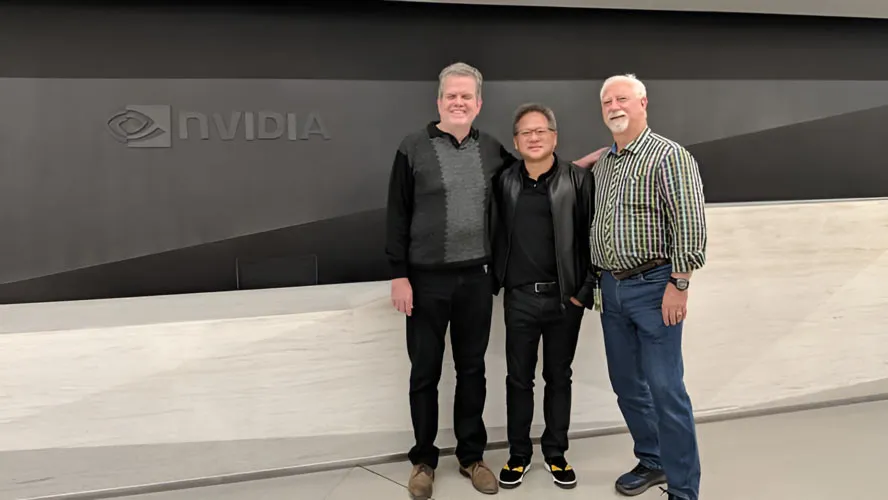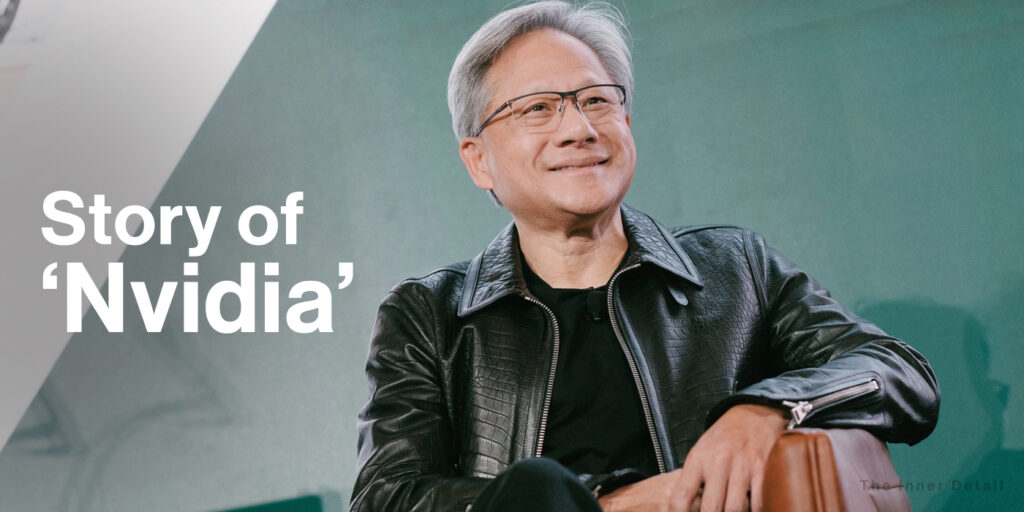Nvidia is now worth over $3 trillion, up 1835% from mid-2018. That’s one of the biggest growths one could ever ask for in 6 years. The company’s story of success majorly attributes not only to the outreach of artificial intelligence, but more than that.
Nvidia’s story is not a fairy-tale business, but a bull-eye approach of the purpose it was started back in 1990s. Co-founded by Jensen Huang, Curtis Priem, and Chris Malachowsky, Nvidia is now valued more than tech giants Apple and Alphabet. Here’s the story of Nvidia, from the start to what it is now with its key attributes to success.
Before we head in to the journey of Nvidia, here are few details about Nvidia.
| Name of the Company | Nvidia |
|---|---|
| Market capitalization | $3.2 trillion (as of June 2024) |
| Founders | Jensen Huang, Curtis Priem & Chris Malachowsky |
| Founded in | April 5, 1993 |
| Products / Industry | GPUs, semiconductor and AI chips |
| Based in | United States |

Story of “Nvidia”
1993: The start of Nvidia’s journey dates back to early 1990s when computers emerged and video games were already popular. The trio wanted to bring 3D graphics into gaming applications in computer and that was the birth of Nvidia. Founded on April 5, 1993, Nvidia’s first vision was to bring 3D graphics to the gaming and multimedia markets, which will enhance the video-gaming infrastructure.
1995: The first product of Nvidia was a graphics accelerator called “NV1”, which the company unveiled in 1995. It used quadrilateral shapes as building blocks of computer graphics, contrary to triangles used by its competitors. Nvidia’s very first product “NV1” failed in the market to triangular approach.
This was the time when Nvidia was close to going bankrupt. But Sega, a Japanese video game console manufacturing company saw the potential in Nvidia and invested $5 million in the company.
1996: Learning from the failure, Nvidia manufactured a graphics accelerator that had triangular approach as its peers. Called “RIVA 128”, the product became a massive success when it was released in 1996.
“Our company is thirty days from going out of business.”
1999: Then, Jensen Huang, Curtis and Chris thought that video gaming will be a massive business in future and it may need advanced massive computations at breakneck speed, which normal computers will not be capable of doing.
They predicted that future gaming will be visually engaging and CPU will not be efficient enough to support that. Hence the trio came up with “graphical processing unit” (GPU) that functions parallel to CPUs and will support advanced gaming applications and reshape the computing industry.
Since Jensen was working as a division head at LSI Logic, building specialized integrated chips, he was familiar with computer products and its infrastructure.
Nvidia invented world’s first GPU called “Geforce 256” in 1999, that gave Nvidia jet-launch in its business. It was the same year, when Nvidia filed for its IPO at $12 per share.
2000s: Geforce 256 was a huge success that it made Nvidia one of the S&P 500 companies in United States. Nvidia was investing heavily in R&D for enhancing the computing power and this has helped the firm over the years. In 2000, Microsoft became a customer for Nvidia, as Nvidia started supplying GPUs for Microsoft’s Xbox gaming console. After Microsoft, Apple’s personal computer was equipped with Nvidia’s GPU.
In 2006, the company developed CUDA (Compute Unified Device Architecture) platform, which allows GPUs to be used for non-graphical advanced computing tasks, including AI and machine learning.
2012: 2012 was the year in which Nvidia sowed the seeds of Artificial Intelligence. A researcher from University of Toronto used just two GPUs of Nvidia to power his convolutional neural network, which is an artificial neural network for image processing, natural language processing and pattern recognition.
Over the years, Nvidia intuited that AI will be the future and started making GPUs that supports machine learning and AI technology.
2016: Nvidia launched GTX 1080 and 1070 in 2016, which became a behemoth success in the realm of PC gamers. These GPUs that came on the back of GTX 700 and 900 series graphics cards, became dominant force in the market. At this time, Nvidia had 70% of market-share in GPUs, and 30% being taken by AMD.
Subsequent releases of GTX 1600 series and RTX 2000, 3000 and 4000 series sky-rocketed Nvidia’s worth. In just two years, Nvidia’s GPU market share boomed up from 70% to 81%.
2018: Nvidia’s GPU made with the Volta and Turing architecture in 2018 greatly powered advanced computing, especially cryptocurrency mining operations when it started to boom in late 2019s. This further uplifted the feat of Nvidia.
The GV100, A100 and subsequent GPU models along with RTX had targeted AI data centers where GPUs power the processing of artificial intelligence, for solving complex matrix calculations, that are the building blocks of AI models. Nvidia RTX was the first GPU capable of real-time ray tracing. These GPUs were broadly welcomed by the developers all around the globe.


2020 to current: The rise of AI benefitted Nvidia like no other technology. Growth of generative AI paved Nvidia the way to become a trillion-dollar company. Nvidia’s Hopper-based chip H100 containing 80 billion transistors, is three to six times more powerful than A100. The company also released its upgraded versions like GH200 Grace Hopper superchip, which is specially designed for giant-scale AI and high-performance computing applications. The chips designed were significantly speeding up the operations of large language models by 30 times compared to its earlier versions. Recently released Blackwell chip is the world’s most powerful AI chip ever made till date.
Tech giants such as Amazon, Alphabet (Google), and Microsoft started becoming customers of Nvidia for powering their data-centers using AI. Nvidia’s AI platform has emerged as an AI factory for AWS, Google Cloud, Microsoft Azure and Oracle Cloud infrastructure.
Trillion $ company
Nvidia was worth $155 billion in 2018 and in just six years, the company’s value went up by 1835%. As of June 2024, Nvidia’s net worth stands at $3.2 trillion. Jensen Huang with a 3.8% stake in the company, is now worth $126 billion, making him one of the top-15 richest people in the world.
Since it’s anticipated that the AI boom will still foster in future, the market cap of Nvidia may go as high as $10 trillion by 2030, says analyst. Indeed, Nvidia briefly became world’s most valuable company surpassing Microsoft in mid-June 2024.
As long as technology and AI will continue expanding, Nvidia will be hitting skies higher and higher.
(For more such interesting informational, technology and innovation stuffs, keep reading The Inner Detail).
Kindly add ‘The Inner Detail’ to your Google News Feed by following us!







